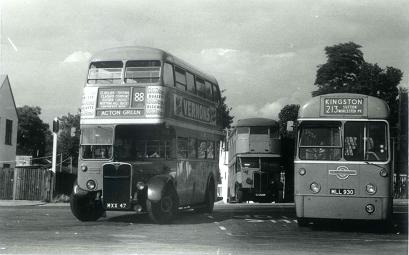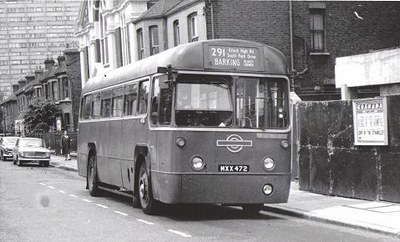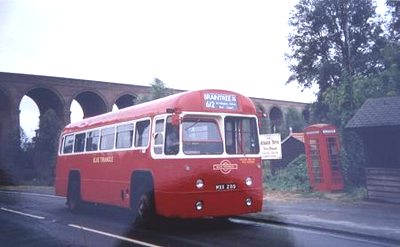The old and the new, 1952
style. 'Scooter' LT1093 represents the pre-war generation at
Clapton Pond on 13 October 1952, on route
208. RF303 is the new order, in the fifth
day of RF operation of the second red RF route, the
208A. In three months time,
there would be no more Scooters operating in London.
After the second world war, London Transport’s
red bus fleet needed major renewal. First in line were the
double-deckers, always by far the largest part of the fleet, as it
had long been LT policy to operate double-deckers wherever
physically possible. From 1947 to 1954, LT rapidly built up
the largest fleet of standardised double-deckers in the world, the
RT family. Between 1946 and 1948,
as a stop-gap measure, it also purchased 181 new red single-deckers
(the TDs and post-war Ts) of pre-war design. Meanwhile, it
continued to run a large number of elderly single-deckers,
including Ts dating from 1929-32, LT
Scooters from 1931 and 5Q5s from 1936. In 1951, there was a
service requirement for 385 single-deckers, mainly on routes where
low bridges made double-deck operation impossible.
New design ideas were applied to the 1949
prototype AEC Regal IV, UMP227, trialled by London Transport in
1950-1 and now under restoration at the
London Bus Museum. This high-floored bus had a centrally
mounted underfloor engine, laid on its side. The flat front
and front entrance (as previously seen on the Q-class) gave maximum
internal space (as well as the potential for future one-man
operation). The trial was a success and the RF was born.
The RF's AEC chassis carried a 9.6 litre
diesel engine under the floor, with access via detachable panels on
the offside. Apart from changes arising from being laid on
its side, this engine was essentially similar to that carried by
the RT. Bodywork was provided by Metro-Cammell of Birmingham,
previously a supplier of trolleybus bodies but not buses.
Metro-Cammell bodywork had an excellent reputation for durability
and the RF has proved to be one of the most robust buses ever
built. 700 were built in four variants, Private Hire coach,
Green Line coach, red bus and green Country bus. The
Metropolitan Police would not permit doors on red buses, as they
were considered to slow down boarding and therefore impede
traffic, so the red buses were built without doors and ran with a
crew of two. Many red RFs were later converted for one-man
operation and doors were fitted, but the London Bus Museum's
RF395 retains its original format.
 Belmont, 2 August 1953. Merton's RT2958 and
Norbiton's RF293 await departure on the 88 and 213
respectively. Both the RT and the RF are less than a
year old, illustrating the renewal of the bus fleet after the war
that enabled the withdrawal of buses such as the ST, which
dates from 1930. By 1953 a mobile
canteen, the former Tilling
ST922 is now restored and resides at the London Bus Museum.
Belmont, 2 August 1953. Merton's RT2958 and
Norbiton's RF293 await departure on the 88 and 213
respectively. Both the RT and the RF are less than a
year old, illustrating the renewal of the bus fleet after the war
that enabled the withdrawal of buses such as the ST, which
dates from 1930. By 1953 a mobile
canteen, the former Tilling
ST922 is now restored and resides at the London Bus Museum.
Photo © Alan Cross
The red RFs carried 41 passengers, a
significant increase on the 35 seats of the Q and LT types.
Given the high volume of bus traffic in the period immediately
after the war, this extra capacity was urgently needed and 225 red
RFs were delivered between September 1952 and March 1953. The
first entered service on 11 September 1952 on route 210, running across Hampstead Heath between
Golders Green and Finsbury Park and
operated by Muswell Hill garage. Ironically, this was one of
the few single-deck routes that had no physical restriction
requiring single-deck operation, but local residents refused to
accept double-deck buses. The same was true on route 200 in Wimbledon – did residents not want
passengers seeing over the shrubbery?
The deliveries allowed the conversion of
thirteen routes to the new buses. North London also saw
conversion of the 212 between Finsbury
Park and Muswell Hill, the 233 between
Finsbury Park and Northumberland Park, the 208A between Clapton Pond and
Stratford and the 208 between Clapton
Pond and Bromley-by-Bow. Closest to the centre of London was
Surrey Docks route 202 between New Cross
and Old Kent Road. Also south of the river, Wimbledon local
route 200 and the busy Kingston to Sutton
route 213 were converted along with
semi-rural route 237 between Hounslow and
Chertsey. Further east, Bromley and Sidcup saw conversion of
the 227 Crystal Palace to Chislehurst,
228 Chislehurst to Well Hall and 241 Sidcup to Welling, and RFs replaced the last
scheduled LT Scooters on Purley to Hackbridge route 234A.
The buses were immediately successful and were
in high demand. Their greater capacity and faster running
allowed enough buses to be squeezed out of the schedules to permit
conversion of Loughton to Woodford route 254 later in 1953. They had allowed the
withdrawal of the pre-war single-deck fleet from the Central Area,
including a fascinating variety of ex-Green Line and Country buses
whose lives had been extended to help out, but leaving in service
the post-war Ts and TDs. The RFs stayed on the same routes
for five years, until a programme of bridge works allowed a series
of routes to be double-decked. First were the 228 and 241 at
Sidcup in 1958, whose RFs were used to convert the 211, 222 and 236, then the 208A in 1959, 212 at
Muswell Hill in 1960, the Uxbridge routes in 1962 and the 213 in
1963. It was the conversion of the 212, by the strengthening
of the weak bridge on Muswell Hill, that brought RFs to the garage
later synonymous with red RFs - Kingston. 21 buses moved
overnight to replace TDs on the 218/219, the routes
which nineteen years later would be the last operators of the
type.
 A new use for the red RF fleet came with the
introduction of one-man operation. Route 291 was one of the
first new routes, formed in 1965 from a section of RT route
129. RF495 is seen in Linton Road, Barking, the massive 1960s
block of flats known as The Lintons contrasting with the
terraced houses.
A new use for the red RF fleet came with the
introduction of one-man operation. Route 291 was one of the
first new routes, formed in 1965 from a section of RT route
129. RF495 is seen in Linton Road, Barking, the massive 1960s
block of flats known as The Lintons contrasting with the
terraced houses.
Photo © Alan Cross
Although ideally laid out for one-man
operation ('OMO', there were no women bus drivers in London until
the 1980s), this was not the plan initially as one-man
operation was limited to buses with up to 26 seats.
Conversion of red RFs for one-man operation started in 1959, once
the country bus fleet was done. This involved fitting doors
and reducing the number of seats by two to 39. However, union
agreement to Central Area driver-only operation had lapsed with the last of the Cubs in 1949 and
renewal of the agreement was not forthcoming. It took five
years before agreement was reached, with the conversion to OMO on
18 Nov 64 of four less busy routes - 201,
206, 216 and
250 (the first three in the Kingston
area, the fourth in rural Essex). Conversion to OMO
continued, with the last crew single-deck route, the 236, losing its conductors on 16 Apr 71.
However, by now RFs were being replaced by new Swifts; not all of the crew red RFs were
converted and surplus buses were sold.
As the reduction in passenger numbers that
started in the 1950s gathered pace and the attractions of cost
reduction by double-decking continued, the inevitable
contraction in the single-deck fleet continued in the 1960s.
Staff shortages and the arguments about Central Area OMO led in
1963 to the Phelps-Brown Committee of Inquiry. One-man
operation gave a new lease of life to the RF in 1964, but LT's
response went further, leading to the infamous Reshaping Plan which brought wholesale change in
1968. Until then, OMO conversion meant using the RF,
providing work for surplus buses in replacing crew RTs in a
reversal of the previous trend towards double-decking where
possible. This process started in October 1965 with the
20B at Loughton and continued
in some cases to use RFs after the introduction of more modern
types, with the North Circular route 212
in September 1971 as the last new red RF route.
Through the upheavals of the Swift era, the
RFs quietly kept running. There were no mass withdrawals
until after the Country Area had been transferred to the National
Bus Company as London Country on 1 Jan 70, taking with it 413
RFs. In the Central Area, LT retained 233 red RFs at the
start of 1970, eight more than originally delivered (by virtue of
transfers from the Country Area). The one-person buses
continued in service in diminishing numbers through the 1970s,
outlasting some of their successors. The last RFs were
planned to finish by 1976, but although RFs were withdrawn from 16
routes in 1976, six routes survived into 1977 - Kingston's 218 and
219, Hounslow's 202 (the second RF route
to bear that number) and 237, the 234A at Croydon and
Edgware's 251. The latter two were
converted to Bristol BL operation in January, with Hounslow
following in April - the 237 having been in continuous RF operation
since December 1952, a period of over 24 years.
But London Transport had a problem. They
had planned to convert routes 218 and 219 (which together needed 19
buses) to Swift operation, but these buses were too long for the
pits at Kingston garage and the unions would not accept them.
There were no more BLs available, so a batch of RFs were
reconditioned and certified for a further three years' service, the
work being carried out at Hanwell and Stonebridge garages.
The 218 and 219 therefore continued as the sole operators of RFs in
LT, until finally a solution was found to the Kingston problem - by
transferring the routes to Norbiton garage. So with due
ceremony (and a week before the end of the RTs on the 62), the last RFs ran in London service on Friday
30 Mar 79, the last one home being RF507 in the early hours of 31
March.
Read the full
story of London Transport's RF fleet.
 Former RF401 working Blue Triangle's route 612
past Chappell Viaduct in Essex's Colne Valley, on a wet day in
August 1990.
Former RF401 working Blue Triangle's route 612
past Chappell Viaduct in Essex's Colne Valley, on a wet day in
August 1990.
Photo © John
Parkin
Since 1979, and indeed since LT started to dispose of its RFs,
these tough buses have found all sorts of alternative uses.
In addition to use by independent operators, they have been used by
a variety of clubs and societies, and many have, directly or
indirectly, entered preservation. It is suggested that at
least 100 of the original 700 are still in existence, with a
handful still earning a living on regular service and private
hires. 28 came together in 2009 at
Sandown Park to mark the 30th anniversary
of the last LT service - all surviving RFs have now more than
doubled their LT life.
The 60th anniversary of the red RFs in 2012 is marked by a
display at London Bus Museum's Spring
Gathering, and later in the year by a number of
route-based events. Details here.